When, in 1916, the 42 year old Reverend Douglas Price was found dead in his house in Rosecliffe Street Highgate Hill, a short but fascinating life had come to an end.
Early years
Price was born into a Quaker family in Birmingham in 1874, one of 2 sons and 5 daughters of Samuel Price and Caroline Southall. When he reached the age of 18, he felt compelled to become a member of the Anglican Church. He was unable to explain why, other than suggesting that the colour and music associated with the church made him feel that those involved had a fuller perception of the revelation of God.
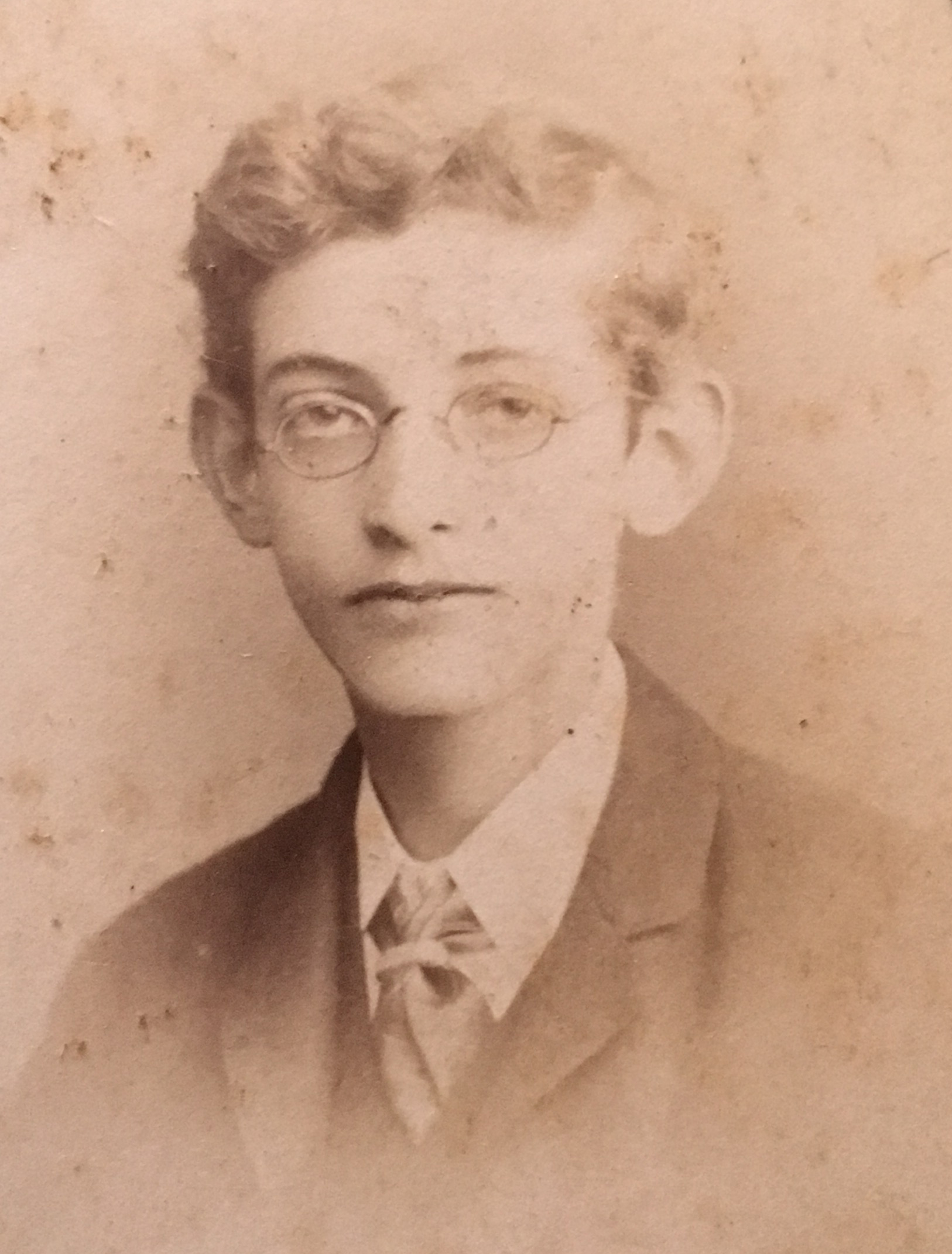
A young Douglas Price. (Courtesy Anglican Records and Archives Centre Southern Queensland)
Four years later, he left his business to study at Durham University and subsequently was ordained in the Anglican Church. He arrived in Brisbane in 1903 to take up a role as lecturer in the Anglican Theological College. Before long, his unorthodox religious beliefs such as questioning the resurrection of Christ, led the archbishop, St Clair Donaldson, to ask him to resign.

St Clair George Alfred Donaldson – First Archbishop of Brisbane (State Library of Queensland)
Rector of All Saints
Around that time, the parish of All Saints church asked Price to become their rector and the issue of his increasingly unorthodox beliefs was avoided for the time being. He had already been associated with this church for several years.
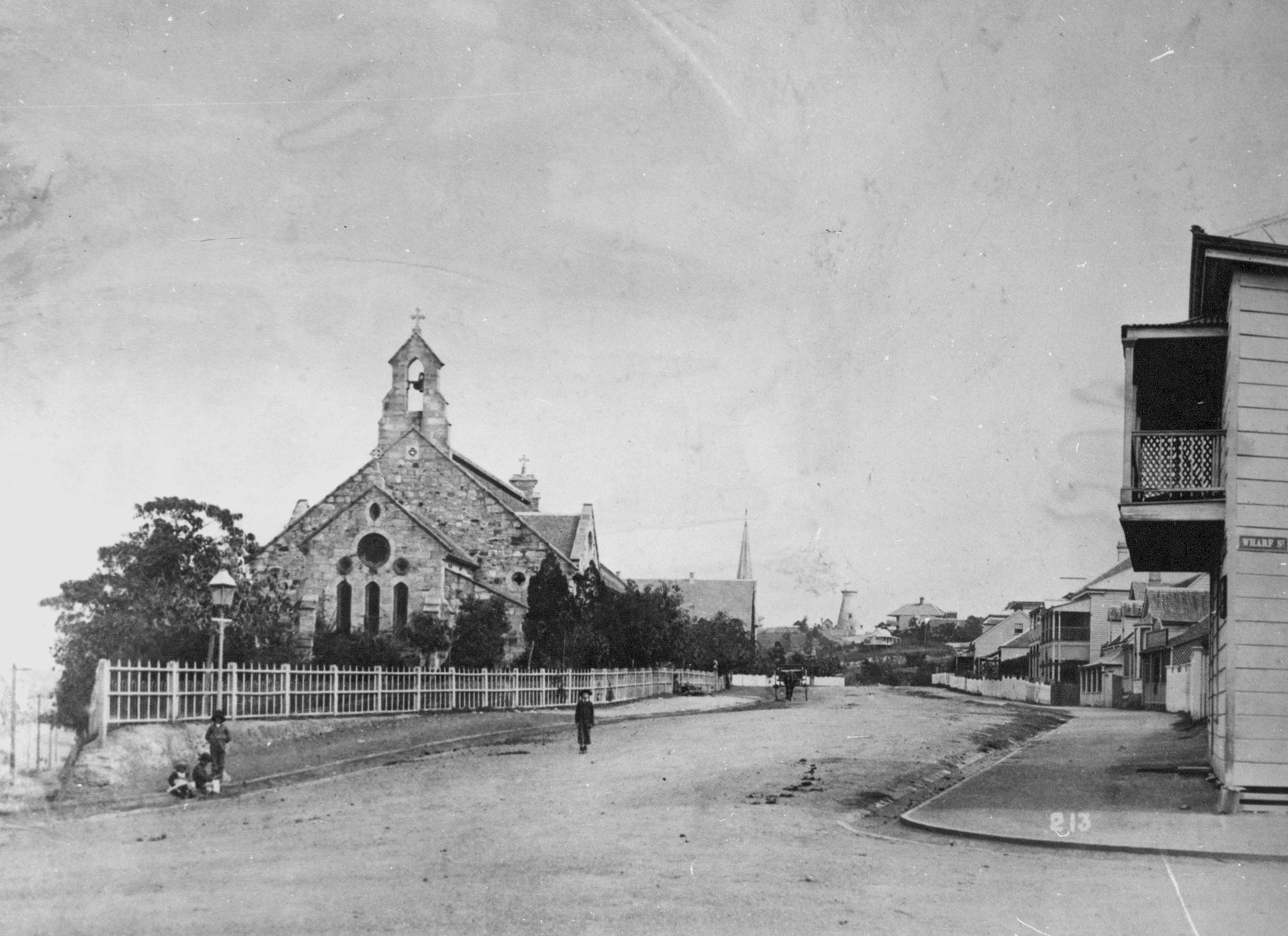
All Saints Church ca. 1885 (State Library of Queensland)
All Saints on Wickham Terrace was the parish church of central Brisbane. Originally built in 1862, in 1869 it was largely rebuilt in the form that exists today, making it Brisbane’s oldest surviving Anglican church.

All Saints Church was built in 1869 and is Brisbane’s oldest Anglican church. (P. Granville)
The Reverend Douglas Price became well known for his sermons. He also continued to give the weekly public lectures he had commenced a few years earlier on subjects such as poetry, philosophy, literature and history, often dressed in University gown and hood.
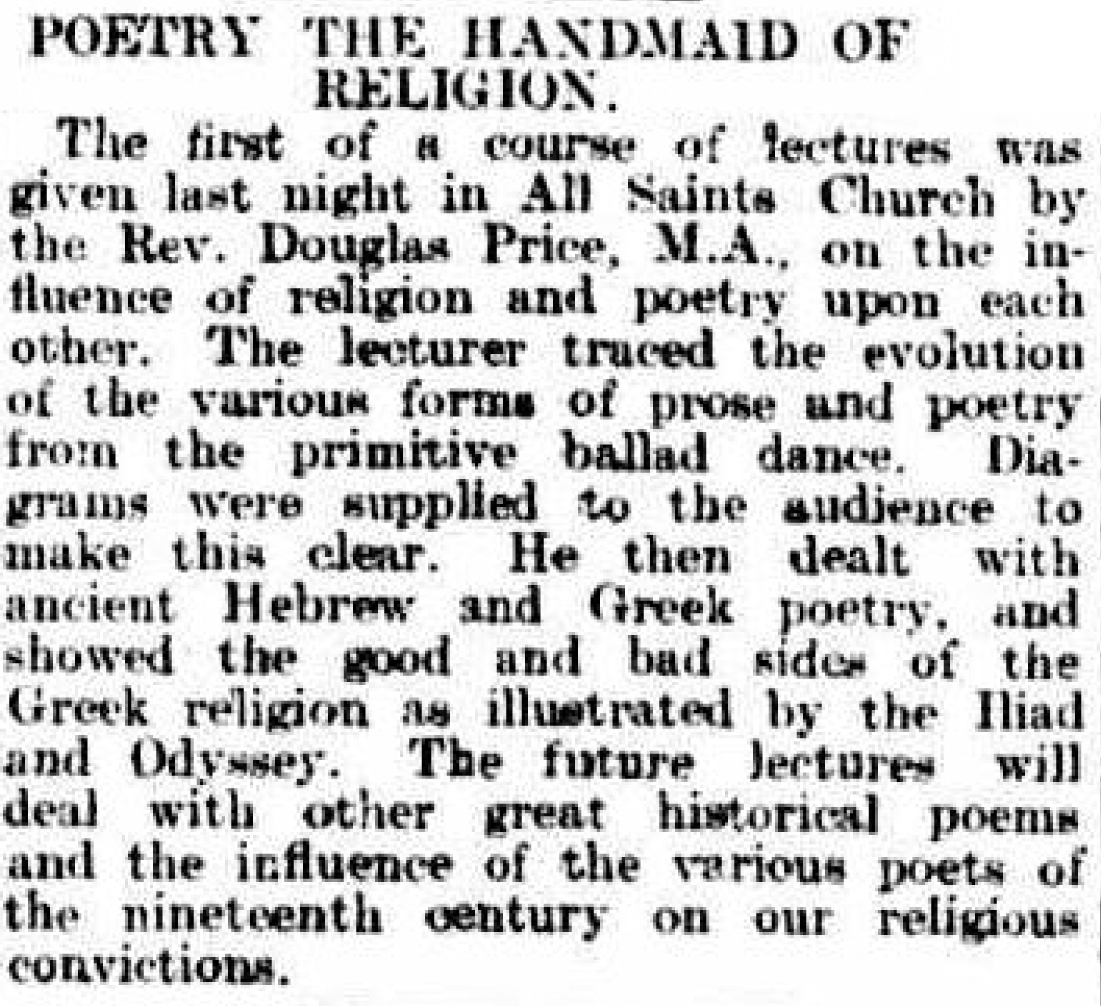
Brisbane Courier 28th September, 1905 (TROVE)
He published a quarterly journal called “The Cygnet” which further expounded his developing ideas. He’s reported to have spent a lot of time in schools and assisting the poor. As the parish had insufficient funds to afford to employ a curate to assist him, he was extremely busy.

Douglas Price with a group of boys. (Courtesy Anglican Records and Archives Centre Southern Queensland)
There was ongoing conflict with Archbishop Donaldson who wanted to close All Saints as Brisbane’s new Anglican cathedral was planned to be built very close by. The Archbishop wanted to maximise the size of the congregation and increase income for the new cathedral building fund.
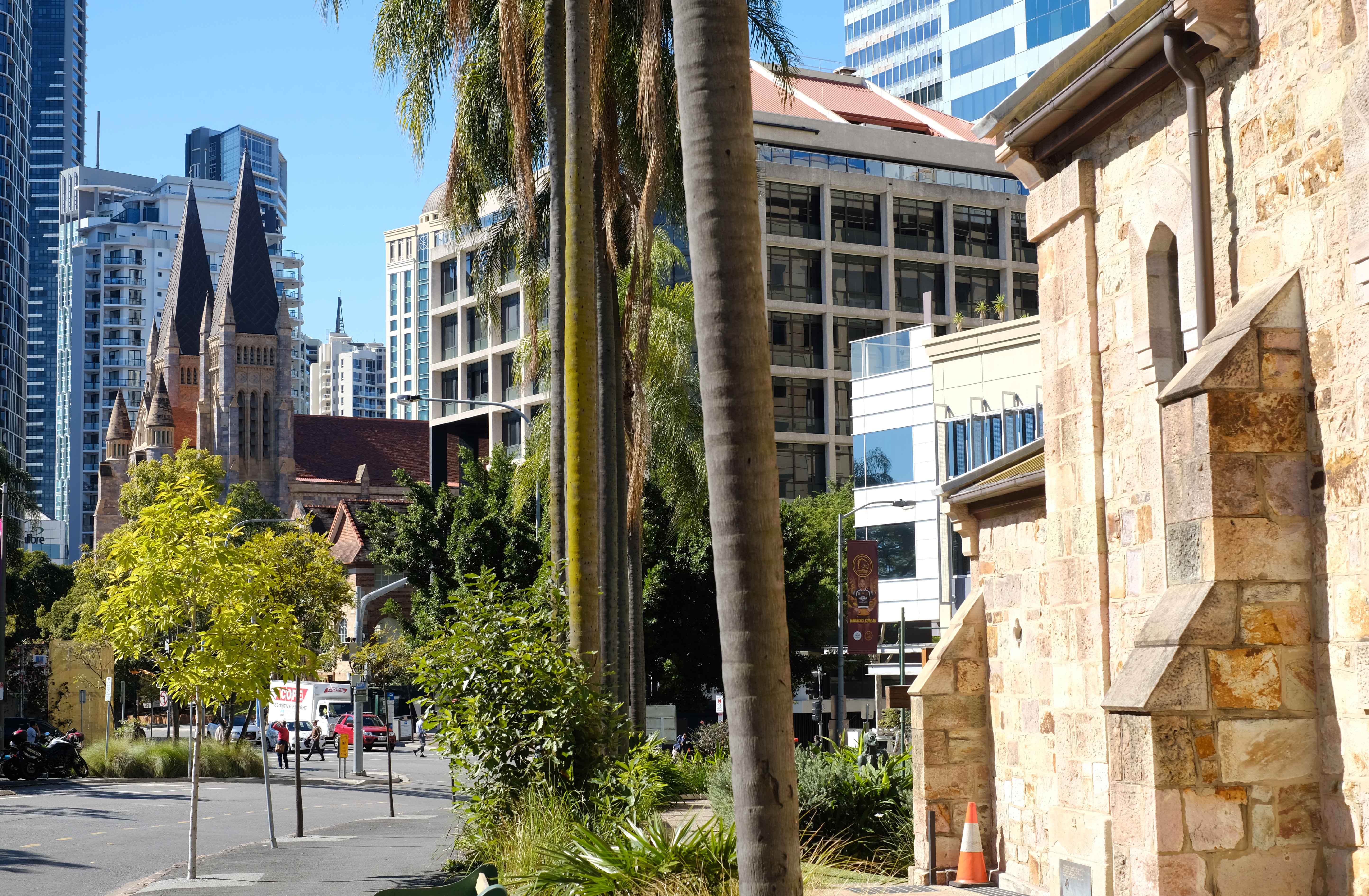
All Saints with St John’s Cathedral in the background in 2018. (P. Granville)
In 1906 a proposal from the archbishop to sell All Saints was rejected by the parish congregation by 200 votes to 9. There was also at this time a bequest to All Saints parish that had been contested by the Synod. This finally was resolved in the parish’s favour in 1910.
Shortly after this, the Archbishop asked Price for copies of his sermons and subsequently asked him to resign. There was some suggestion that this was due to the issue of the disagreement over the future of All Saints Church. However Price’s beliefs had continued to drift further into what was called Modernism. In a word. he believed that Jesus was first amongst the sons of God but was not God the son.
Despite the issues with his theology, the people of the parish were strongly behind him and they petitioned the archbishop to withdrawal his request for Price’s resignation, without success.

Brisbane Courier, 5th January 1911 (TROVE)
He was extremely popular due in part to what was described as a magnetic personality and an ability to speak publicly in an extremely convincing way.
In researching this story in the State Library of Queensland, I came across a personal obituary hand written by E. V. Missing, inserted into a copy of one of the periodicals edited by Douglas Price.
She wrote :
” On hearing him for the first time well might we exclaim with the old philosopher when he heard Plotinus, “This is the man I have been seeking”. His was a chiming soul with syllables of fire“.
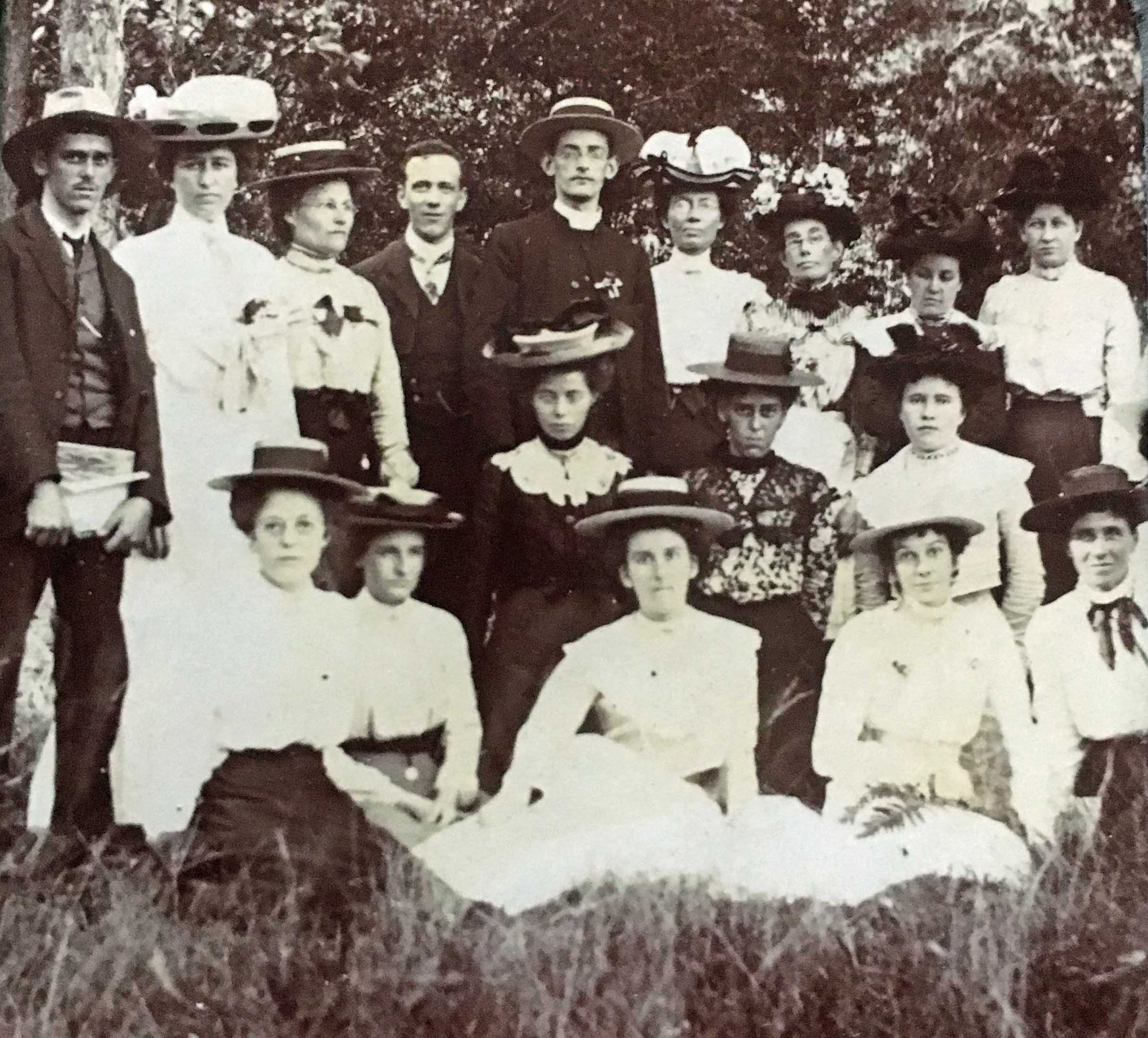
Douglas Price, centre rear wearing the boater, with parisioners. (Courtesy of Anglican Records and Archives Centre Southern Queensland)
The modernist
His forced resignation was reported as far afield as London. Price left for Europe in 1911 after resigning, but later in the same year he returned to Brisbane at the request of his many followers. He established a Progressive Christianity or Modernist Group and held well attended services twice a week.

Brisbane Courier, Monday 4th December 1911. (TROVE)
Dr. A. Jefferis Turner ( see my post Doctor A. Jefferis Turner – “Gentle Annie” ), the President of the Society and another Highgate Hill resident, wrote in his introduction to the first edition of the periodical “Forerunner” in 1914 that the membership comprised
“Christians and Theosophists, Spiritualists and Rationalists, Sceptics, Agnostics and queer sorts of Dogmatists, and cranks of all sorts”.
The Modernist Society later had a library and office in rooms in Moore’s Chambers which stood opposite the GPO at 282 Queens Street where Post Office Square is now located.
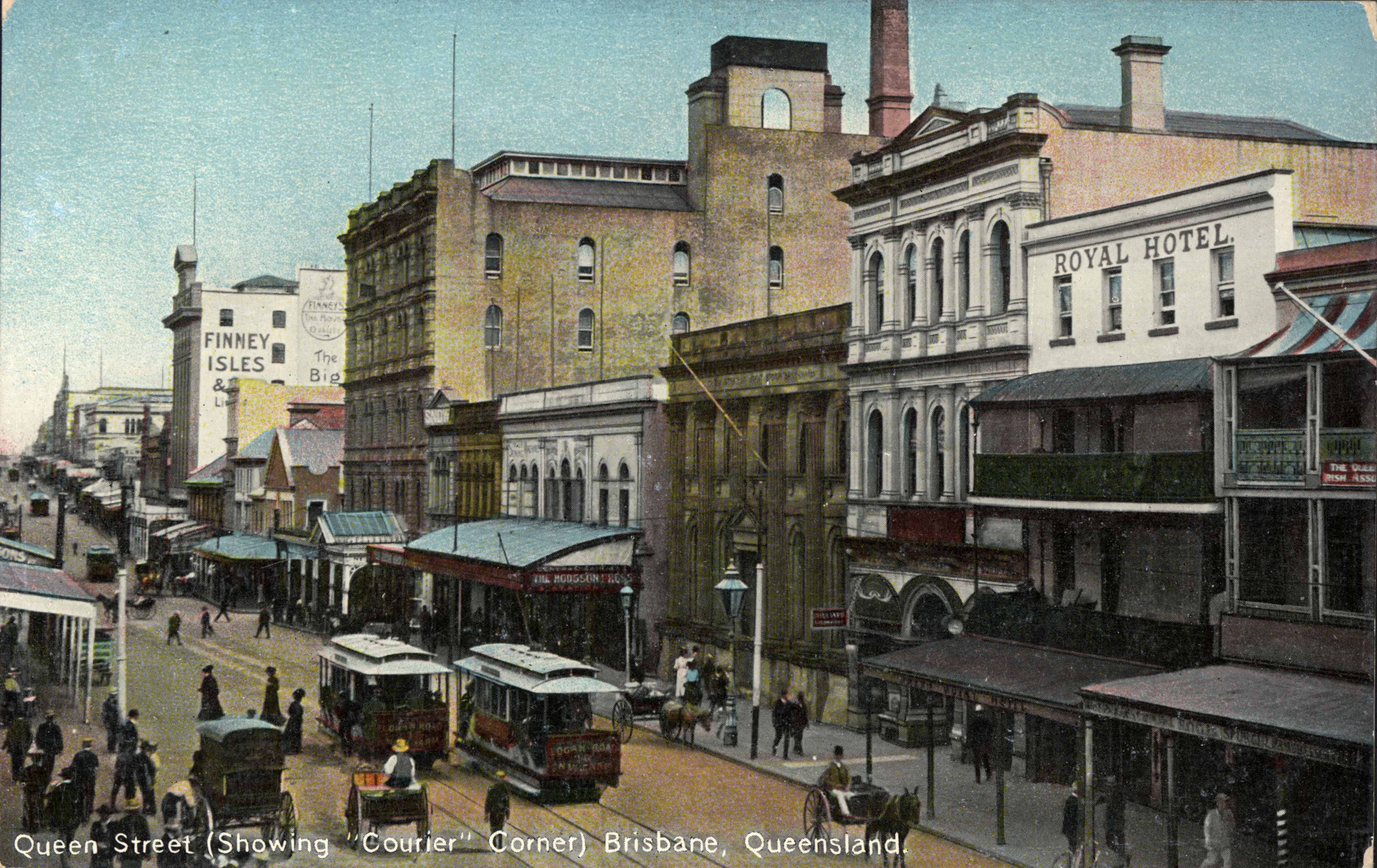
The Modernists had an office and library in the building just visible to the right of the Royal Hotel (State Library of Queensland)
Sunday services were held in the School of Arts and there was a choir, discussion guild and a Ladies Modernist Club.
In his remaining years, Price had a lot more free time than when he was an overworked rector. He published two periodicals, “The Forerunner” and “The Modernist” and wrote three books. “The Soul of Judas” published in 1912 is a book of short stories.”The Earthly Purgatory”, published later in the same year, was described by one reviewer as “an autobiography of a soul”. “One of a Crowd” from 1916 is a novel based on true events concerning a young Brisbane woman. The books contain much of his philosophy and observations of others.

The cover of a Douglas Price novel (Colonial Australian Popular Fiction Archive)
The text of “The Earthly Purgatory” can be found here.
He also built a home in Rosecliffe Street , Highgate Hill which he called “Puck’s Palace.
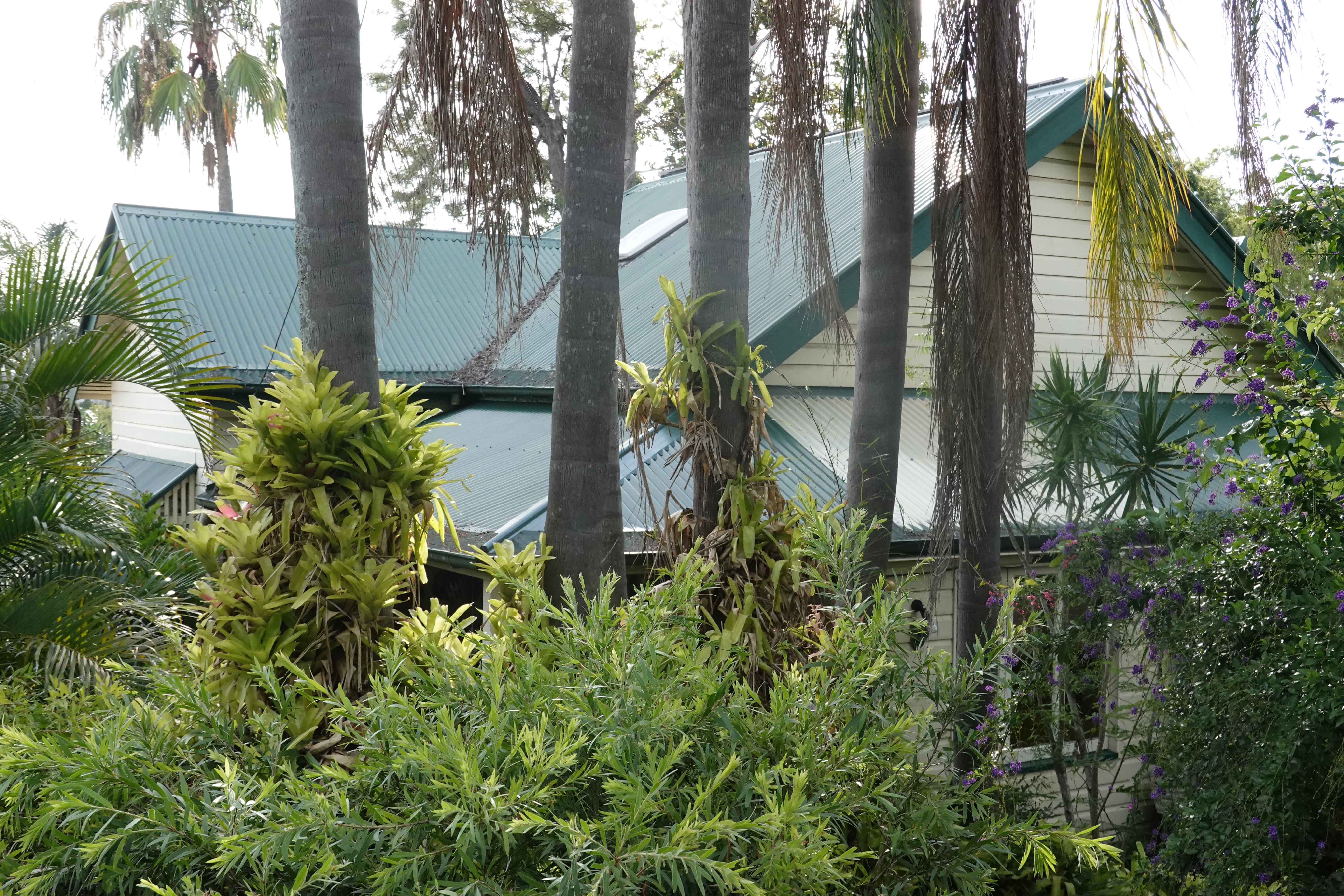
“Puck’s Palace” at 57 Rosecliffe Street. (P. Granville)
As well as being an author, Price was also gifted musically and artistically and his house had internal black and white decorations painted by him. The frieze in his study was described as being a representation of his philosophy and was still preserved in 1929.
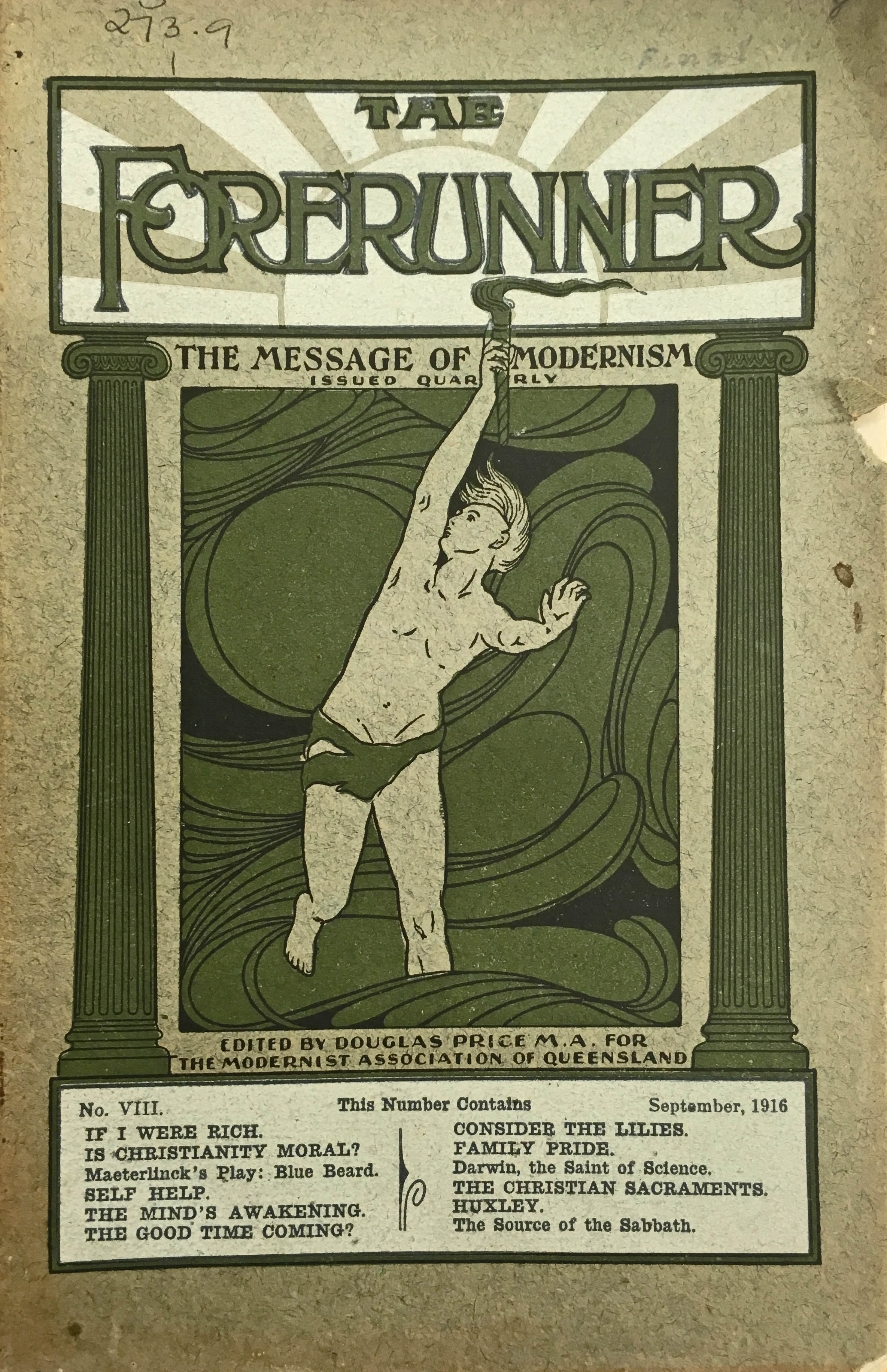
The cover of the “Forerunner” periodical designed by Douglas Price. (State Library of Queensland)
Price took a strong anti-war stance and in August 1915, he chaired a meeting entitled “Christianity and War” decrying the situation in Europe. Margaret Thorp, visiting from Tasmania, was the main speaker. Soon after, she moved to Brisbane and became a close friend of Price’s and a leading anti-conscription figure. In 1916 she was living close by in Borva street.
A tragic end
In December of 1916, Douglas Price was found dead at home by a friend who had come to visit. He was a believer in eugenics and had decided not to marry and have children and he lived alone.
One newspaper stated that there was no sign of foul play and that he had seemed to have died of natural causes. Another euphemistically reported that he had died in his sleep.
My interest piqued, I obtained his death certificate issued after an autopsy, which states that he died from a severed brachial or upper arm artery, haemorrhage and syncope. Given that there was no police investigation, it’s certain that he committed suicide, probably by slicing through his underarm. Price suffered from a long term painful illness which may have been a cause of his decision to end his life.
Just months earlier he had written the following in the ‘Forerunner’ periodical in the context of the war then raging in Europe. Does this argument against suicide represent his troubled mind at the time?
“Some will probably despair of this world and transfer their hopes to a future sphere. It is good to hope for better things beyond the silence of death. But our first business is here and now, and we have no right to neglect our mundane duties that we may selfishly dream of eternal bliss. I have no wish to pour scorn on anyone’s post mortem dreams. I have some myself. But religion is surely the making of things better in this world. And now the call is upon us to seek to save the high things already secured.”
A 1929 newspaper article on Highgate Hill unexpectedly devotes half its column space to a description of Price and was obviously written by a close acquaintance. The author makes the following comment on Price’s death.
“His passing, like his life, was tinged with the unusual. Like a Roman senator who had incurred his Emperor’s displeasure he expiated, in the old Roman way, his failure to adjust himself to his environment.”

Douglas Price (from All Saints records held by State Library of Queensland)
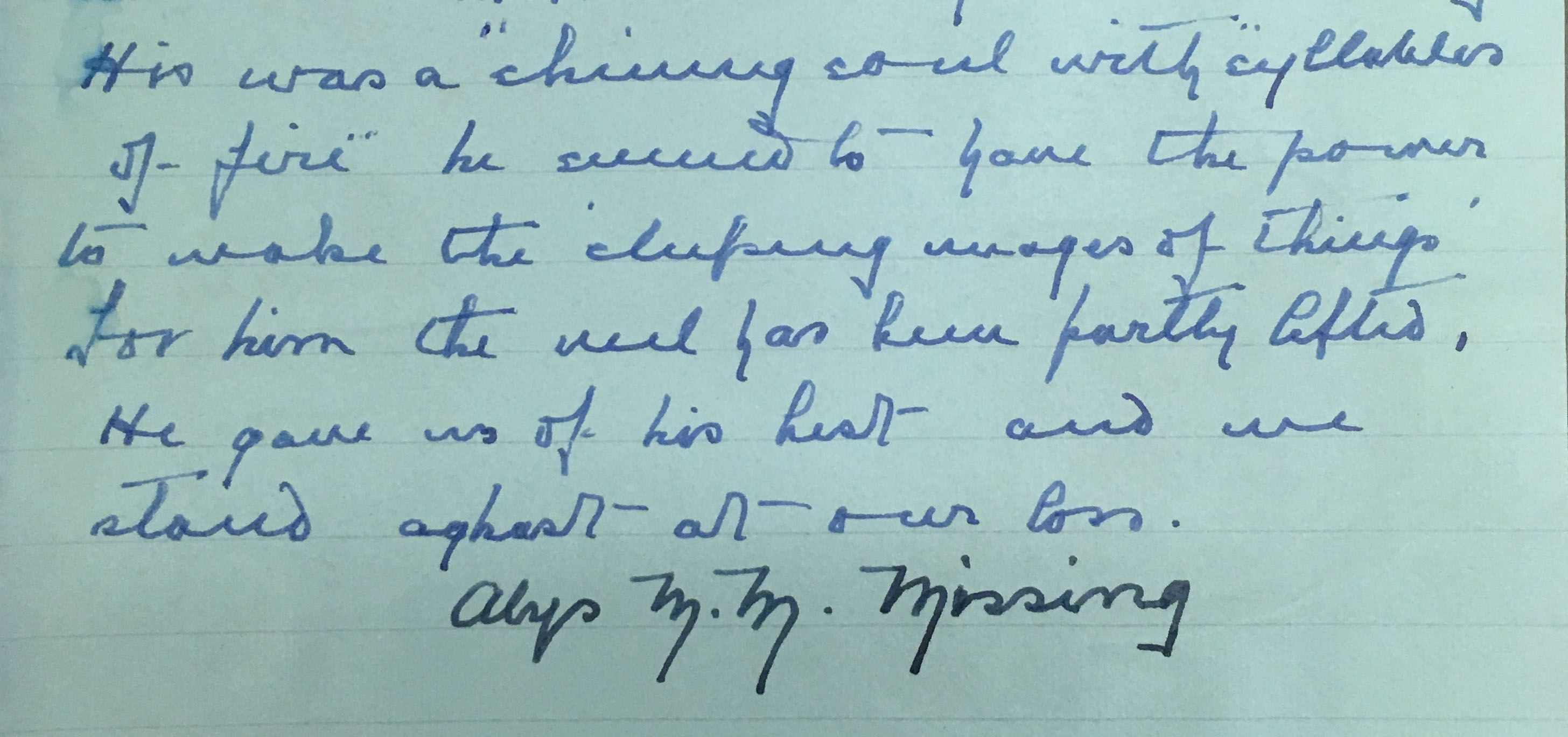
A fragment of the personal obituary I found inserted in a copy of one of Douglas Price’s periodicals. (State Library of Queensland).
A yearly Douglas Price Memorial Lecture was held for some years from 1920 and presented by distinguished academics. In 1921, the lecture was presented by Elton Mayo, Professor of Psychology and Philosophy at the University of Queensland. Another blogger has discussed this in her post ‘Civilisation and the Inner Self’ .
A 1921 newspaper article regarding this lecture by an acquaintance gives us a glimpse of his character.
“Douglas Price’s love for the beautiful in life was his most vivid characteristic – beauty of mind, physical beauty, lovely words that blaze like jewels, music that frees the soul, art, nature, truth, kindness- all these things were to him just God.”
The article mentions that without a successor, the Modernist Movement in Brisbane had become ‘moribund, if not dead’.
One of his obituaries stated that had Douglas Price lived anywhere but Australia, he would have had a world wide reputation, but he is now all but forgotten.
His fallen tombstone can be found in the South Brisbane Cemetery.
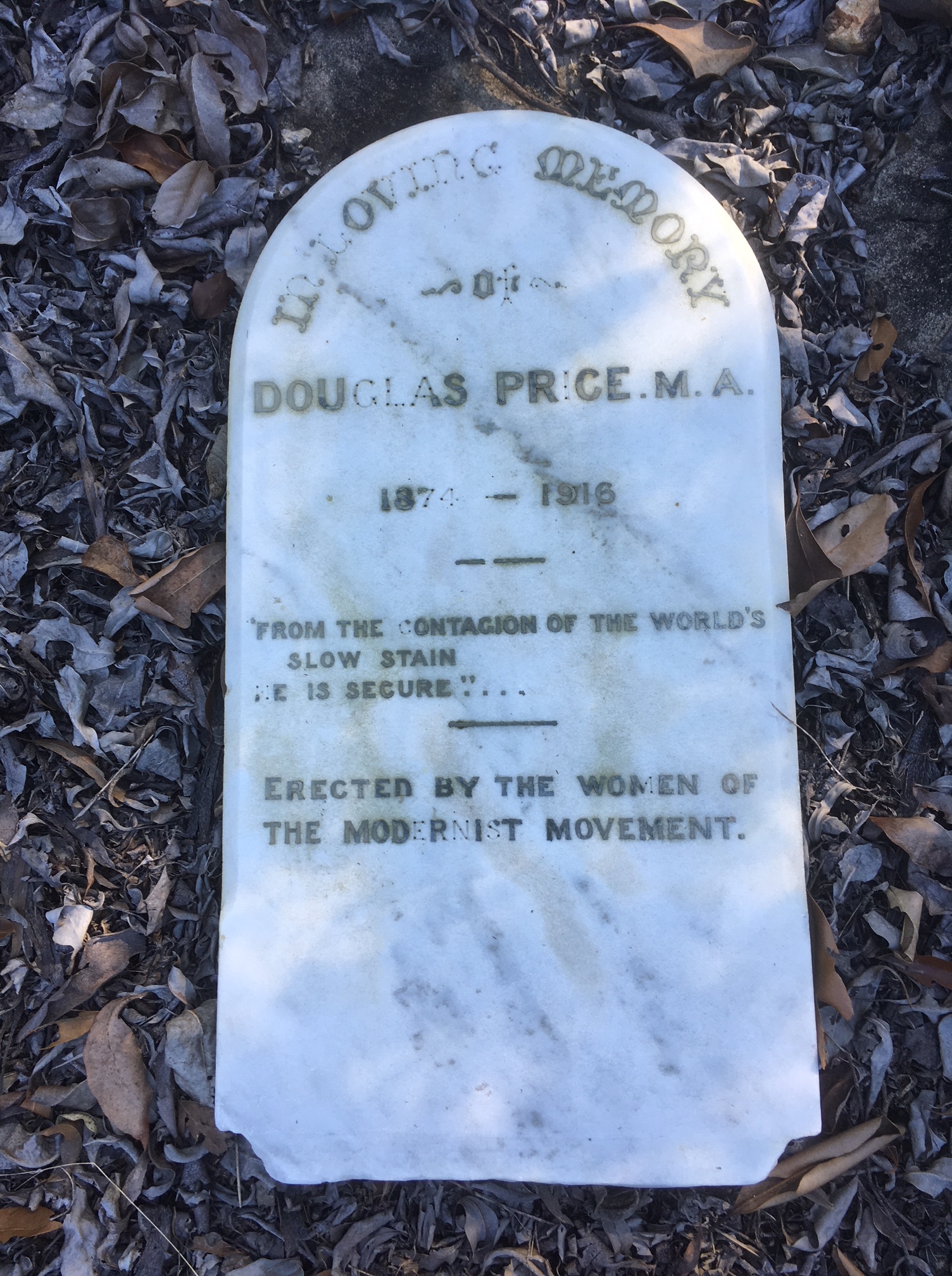
Douglas Price’s Tombstone in the South Brisbane Cemetery at Dutton Park – erected by the women of the Modernist Movement. (P. Granville)
Further reading
A History of All Saints 1862 – 1937
The unusual discovery of Douglas Price’s photograph album – The mysterious photo album of a rebel priest
© P. Granville 2018
What a wonderful account of a very interesting man – and thankyou for ‘pinging’ on my blog entry at Freud in Oceania to develop this piece! I would love to see Price’s contribution ‘recovered’. I agree with you about the possibility that Price committed suicide and wonder, also whether his personal life was rather troubled. There are some interesting reviews of his books in the Australian press. One of them compared his novel, ‘This earthly purgatory’ with Wilde’s Portrait of Dorian Gray.. I will be following your blog too.
Kind regards, Christine
LikeLike
Thanks so much Christine, I was going to send you a message about the death certificate information I uncovered now that I’ve published the post . I’ve asked a few doctor friends who tend to think that suicide is the most likely cause of death and that such things weren’t published in newspapers in those days. I’m afraid my little blog is nowhere near as academic as your impressive one. I do have another post about an unusual person though – Ebenezer Thorne.
LikeLiked by 1 person
Thanks Paul, I will have a look.
I would like to see Price’s story recovered… his novels are interesting.
Kindly
Christine
LikeLike
A wonderful story, and a fine piece of writing, thanks Paul.kind regards Richard.
LikeLike
Thanks very much Richard.
LikeLike
Good Morning,
I am an Archives Researcher with the Brisbane Anglican Diocese writing an article in Rev’d Price, well about a photograph album of his actually that made its way to our collection. Your article has been very informative and helpful in my research, thank you so much!
LikeLike
Hi Adrian, I’m so glad that my little post has been of help. It certainly was an interesting moment when I obtained his death certificate. The photograph album must be fascinating. Will you be publishing any of the photos in your article ? I’ll keep an eye out for it.
I remember visiting the archive many years ago looking for information about my great great grandfather who arrived in Brisbane in 1865 to take up a role as school teacher at St. John’s School. I was told there were no surviving records but would there be bishop’s correspondence files from that time ? I know that he was in contact with the bishop before coming out.
LikeLike
Hi again. I have used the tombstone pic, fully attributed of course, but sources all other images from our own collection and one from Trove.
If you would like to email me details I can see what I can find re: your ancestor no problem. Either the address provided here or archives@anglicanchurchsq.org.au. Happy to help.
LikeLike
Thanks very much I’ll send you the details by email . I was thinking of the photos in Douglas Price’s photo album when I made the comment.
LikeLike
Oh and the Bishop at that time would have been Tufnell. We have some correspondence, not a lot!
LikeLike
Oh sorry. Yes there are a couple of snaps in the article. Hoping to have the whole album scanned to share with everyone at some point. Have also heard the Rector at All Saints has a picture of Rev’d Price sitting in the parish office!
LikeLike
Reblogged this on Women Peace-makers and commented:
Douglas Price opposed World War 1? It certainly supported Margaret Thorp, the Quaker Peace Angel, in her work promoting an negotiated end to World War 1.
LikeLike
Hi Yes Douglas Price was a strong anti-war advocate and I believe a close friend of Margaret Thorp. I’ve just done a bit of quick research – have a look at page 245 of this book.
Paul
https://books.google.com.sg/books?id=Fgk4AAAAIAAJ&pg=PA245&lpg=PA245&dq=margaret+thorp+douglas+price&source=bl&ots=peV1vAYtQ8&sig=ACfU3U1XZK4vqSkT4LK8tkfrEvA-nQtE1g&hl=en&sa=X&ved=2ahUKEwja_Nv6-OThAhUCaI8KHQaZBT0Q6AEwDHoECAQQAQ#v=onepage&q=margaret%20thorp%20douglas%20price&f=false
LikeLike
Pingback: Doctor A. Jefferis Turner | Highgate Hill and Its History
Hi Paul
Thanks for a very interesting article.
I have a copy of Price’s, One of a Crowd.
With your research, email replies and contacts etc do you know of anyone who may be seeking a copy of this book?
LikeLike
Hi Mike, I had a second-hand book dealer get in touch with me a while ago. He had a copy of “Earthly Paradise” and was going to offer it for sale to the National Library as they didn’t have a copy in their catalogue. I see from a search on Trove that quite a few libraries have a copy of “One of a Crowd” although the Queensland State Library don’t so that might be a possibility. Paul
LikeLike
State Library of Queensland holds a number of titles by The Reverend Douglas Price in the John Oxley Library collection, including One of a crowd http://onesearch.slq.qld.gov.au/permalink/f/fhnkog/slq_alma21130532360002061 and The Earthly purgatory http://onesearch.slq.qld.gov.au/permalink/f/fhnkog/slq_alma21132388510002061
LikeLike
Thanks for some reason on a TROVE search it comes up in 5 libraries but not SLQ. https://trove.nla.gov.au/work/21342388?keyword=douglas%20price%20one%20of%20crowd
LikeLike
Thanks, Paul.
I did note a few of the State Libraries had copies. Though it does appear to be uncommon outside those institutions. I’ll make some enquiries.
Mike
LikeLike
I enjoyed readingg your post
LikeLiked by 1 person